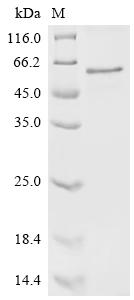Recombinant Human SMAD3 is a full-length protein expressed in E. coli, spanning amino acids 1 to 425. This product comes with an N-terminal 10xHis-tag, which makes purification and detection much simpler. The protein achieves a purity level above 90%, confirmed through SDS-PAGE analysis. Intended for research use only, this recombinant SMAD3 appears to be a solid choice for scientific studies that need high-quality proteins with minimal endotoxin contamination.
SMAD3 acts as a critical intracellular mediator in the TGF-beta signaling pathway. It plays a significant role in regulating various cellular processes—proliferation, differentiation, and apoptosis among them. As a transcription factor, SMAD3 transmits extracellular signals to the nucleus, where it influences gene expression. Its involvement in these pathways likely makes it an essential protein for research into cellular communication and regulatory mechanisms.
Potential Applications
Note: The applications listed below are based on what we know about this protein's biological functions, published research, and experience from experts in the field. However, we haven't fully tested all of these applications ourselves yet. We'd recommend running some preliminary tests first to make sure they work for your specific research goals.
Based on the provided information, the recombinant human SMAD3 is expressed in E. coli, a prokaryotic system that is generally unsuitable for producing properly folded eukaryotic signaling proteins like SMAD3. SMAD3 requires precise folding of its MH1 and MH2 domains, proper oligomerization capabilities, and specific post-translational modifications for its transcriptional co-activator function in TGF-β signaling. While the protein is full-length (1-425aa) with an N-terminal 10xHis tag and >90% purity, E. coli lacks the eukaryotic chaperones and modification machinery necessary for the correct folding of complex signal transduction proteins. The presence of the His-tag may further interfere with native protein structure and function. Since activity is unverified, the protein cannot be assumed to be correctly folded or bioactive without experimental validation of its DNA-binding capability, SMAD4 interaction, and phosphorylation responsiveness.
1. Protein-Protein Interaction Studies via His-Tag Pull-Down Assays
The N-terminal 10xHis tag enables technical immobilization for pull-down assays, but if SMAD3 is misfolded (as likely in E. coli), it will not interact physiologically with true binding partners (e.g., SMAD4, receptor complexes). The MH2 domain requires precise conformation for specific oligomerization. Identified interactions may be non-physiological artifacts. This application should only be pursued after confirming proper folding and SMAD4 interaction capability.
2. Antibody Development and Validation
This application is appropriate as the safest use case. The recombinant SMAD3 can serve as an effective immunogen for generating antibodies that recognize linear epitopes, even if misfolded. The full-length sequence ensures broad epitope coverage. However, antibodies may not recognize conformational or phosphorylation-dependent epitopes of native SMAD3. Validation against phosphorylated, endogenous SMAD3 from mammalian cells is essential.
3. Biochemical Characterization and Biophysical Analysis
This application is well-suited and should be prioritized. Techniques like circular dichroism spectroscopy, analytical ultracentrifugation, and thermal shift assays can directly assess the protein's folding state, oligomerization behavior, and stability. These studies are valuable even if the protein is inactive, as they characterize the recombinant product itself and inform about its suitability for other applications.
4. In Vitro Binding Assays with TGF-β Pathway Components
This application is highly problematic without activity verification. If SMAD3 is misfolded, it will not bind DNA properly via its MH1 domain or interact specifically with SMAD4 via its MH2 domain. Binding assays will yield misleading affinity data. This application requires prior validation of DNA-binding and SMAD4 interaction capabilities using known response elements and binding partners.
Final Recommendation & Action Plan
Given the high probability of misfolding in E. coli for this complex eukaryotic signaling protein, we recommend first performing comprehensive biophysical and functional validation. This should include: 1) Biophysical characterization (circular dichroism for secondary structure, size-exclusion chromatography with multi-angle light scattering for oligomeric state); 2) Functional validation (DNA-binding assays using SMAD-responsive elements, SMAD4 interaction tests). Antibody development can proceed immediately as the lowest-risk application. Avoid all interaction and binding studies until proper folding and function are confirmed. For reliable SMAD3 functional studies, consider obtaining the protein from mammalian or insect cell expression systems capable of proper folding and post-translational modifications. Always include appropriate controls such as known SMAD3-responsive DNA elements and validated binding partners.






